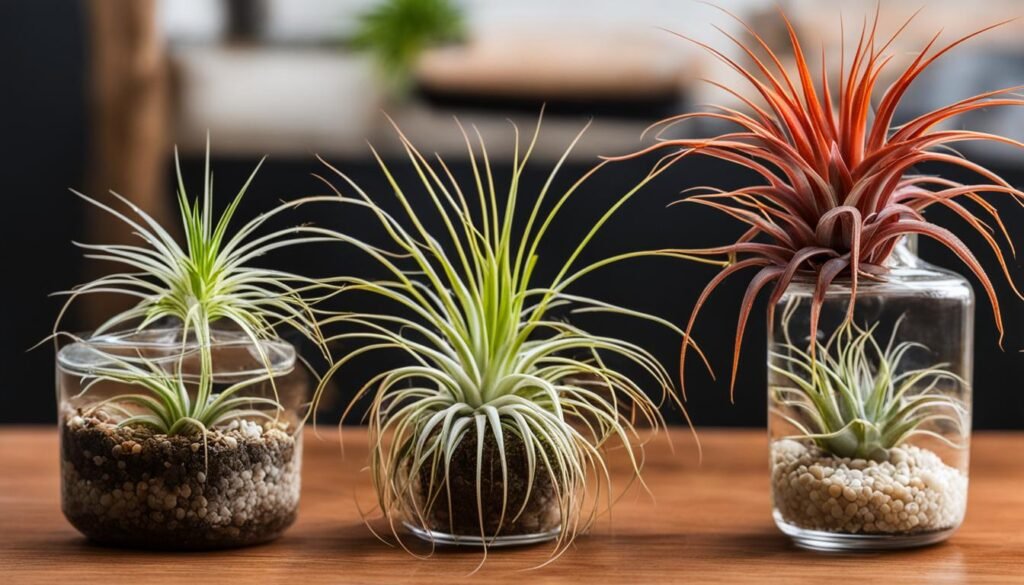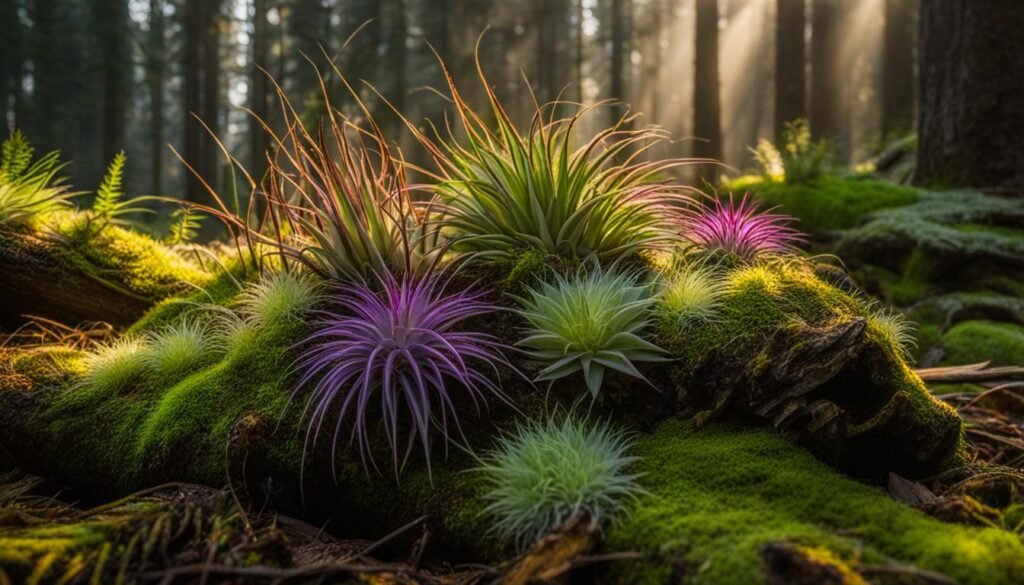Air plants, also known as Tillandsia, are intriguing plants that have gained popularity as houseplants. They are known for their ability to survive without soil and their unique rosette-shaped foliage. But how long do air plants actually live? Let’s dive into the fascinating world of air plants and explore their lifespan and the factors that influence it.
Key Takeaways:
- Air plants, also known as Tillandsia, can live for several years with proper care.
- The average lifespan of air plants varies between species and individual plants.
- Environmental factors such as sunlight, temperature, humidity, and airflow influence the lifespan of air plants.
- Caring for air plants involves proper watering, fertilizing, and addressing pests and diseases.
- Tricks like grooming and choosing suitable displays can help prolong the life of air plants.
What Are Air Plants and Where Do They Come From?
Air plants, also known as Tillandsia, are fascinating plants that have become popular as houseplants. Unlike most plants that require soil for growth, air plants have adapted to live without it. Instead, they attach themselves to trees, rocks, or other surfaces, relying on air and rainwater for their survival.
Air plants belong to the Bromeliad family and can be found in various habitats across the Americas. They have evolved to thrive in diverse environments, from tropical rainforests to arid deserts. With over 650 species, each air plant has its own unique characteristics and care requirements.
Understanding the natural habitat and origins of air plants provides valuable insights into their lifespan and care needs. By replicating their native conditions, you can help create an optimal environment for your air plants and ensure their longevity.

What Are Air Plants and Where Do They Come From?
| Common Name | Scientific Name | Native Habitat |
|---|---|---|
| Spanish Moss | Tillandsia usneoides | Southern United States, Central America, South America |
| Xeric Air Plant | Tillandsia xerographica | Mexico, Central America |
| Ball Moss | Tillandsia recurvata | United States, Mexico, Central America, South America |
| Queen of Air Plants | Tillandsia aeranthos | South America |
Each air plant species has its own unique characteristics and care requirements, so it’s essential to research and understand the specific needs of the plants you have.
Now that we’ve explored the origins and natural habitat of air plants, let’s move on to the environmental factors that influence their lifespan.
Environmental Factors That Influence Air Plant Lifespan
When it comes to the lifespan of air plants, several environmental factors play a significant role. Understanding and providing the right conditions can help ensure the longevity of these unique plants.
Sunlight
Air plants thrive in bright, indirect light. They should be placed near a window or in a well-lit room where they can receive sufficient sunlight. However, it’s important to avoid direct sunlight, as it can lead to leaf burn.
Temperature
Air plants prefer temperatures between 50°F and 90°F (10°C – 32°C). They can tolerate slightly cooler temperatures, but prolonged exposure to temperatures below 40°F (4°C) can be harmful. On the other hand, extreme heat can cause dehydration and damage to the plant’s tissues.
Humidity
Humidity levels are crucial for air plant health. Most air plants require moderate to high humidity, ideally around 50-60%. Dry air can cause the leaves to dry out and curl, while excessive humidity can lead to rot. If you live in a dry climate, misting the plants occasionally or using a humidifier can help maintain the appropriate moisture levels.
Air Circulation
Adequate air circulation is essential for air plants, as it helps prevent the buildup of moisture and reduces the risk of fungal diseases. Make sure there is sufficient airflow around the plants by placing them in well-ventilated areas. Avoid keeping them in enclosed spaces or areas with stagnant air.
By considering and providing the right environmental factors, such as sunlight, temperature, humidity, and air circulation, you can create an ideal habitat for your air plants to thrive and extend their lifespan.

When it comes to caring for air plants, there are a few common mistakes that you should avoid. By being aware of these pitfalls, you can ensure the health and longevity of your air plants. Let’s take a closer look at some of the most common mistakes:
1. Overwatering:
Overwatering is a common mistake that can lead to the demise of your air plants. While it’s important to provide them with moisture, excessive watering can cause the roots to rot and result in the plant’s death. It’s crucial to find the right balance and avoid saturating your air plants.
2. Underwatering:
On the other hand, underwatering can be equally damaging to air plants. These plants rely on moisture and need regular hydration to thrive. Neglecting to water them adequately can cause them to become dehydrated, resulting in stunted growth and poor health. It’s important to establish a consistent watering schedule to keep your air plants happy and hydrated.
3. Improper Lighting:
Proper lighting is essential for the well-being of air plants. They thrive in bright, indirect light, but direct sunlight can scorch their leaves. On the other hand, insufficient light can hinder their growth and lead to weak, pale foliage. Finding the right balance and providing them with suitable lighting conditions is crucial to their survival.
Avoiding these common mistakes will set you on the path to success in caring for your air plants. By providing them with the right amount of water, ensuring proper lighting, and avoiding overwatering or underwatering, you can enjoy the beauty and longevity of these unique plants.
The Lifespan of Air Plants: What to Expect
Air plants have a variation in lifespan depending on the species and individual plant. On average, air plants can live for several years, with some exceptional specimens lasting up to 10 years or even longer with proper care. Understanding the natural life cycle of air plants can help manage expectations and appreciate the journey of these fascinating plants.
One notable event in the life of an air plant is its flowering phase. Air plants typically bloom once in their lifetime, showcasing vibrant and beautiful flowers that attract pollinators. This bloom is a unique spectacle, and it signifies a significant milestone in the life of the plant.
After flowering, air plants produce offsets, also known as pups, which are smaller plants that develop alongside the parent plant. These offsets provide air plants with a way to reproduce and continue their lineage. Separating the offsets and allowing them to grow independently can result in new and healthy air plant offspring.
| Aspect | Details |
|---|---|
| Average lifespan | Several years, up to 10 years or longer with proper care |
| Flowering | Occurs once in the plant’s lifetime, producing vibrant blooms |
| Offsets | Produced after flowering, providing a means for reproduction |
While the lifespan of air plants can vary, focusing on their flowering phase and the production of offsets adds further excitement and longevity to the overall experience of caring for these unique plants.
Do Air Plants Have a Similar Lifespan to Succulents?
Air plants and succulents may seem similar in terms of their low water requirements, but they have notable differences in their lifespans. While succulents store water in their leaves, stems, or roots, understanding air plants as succulents can be misleading. Air plants primarily obtain moisture and nutrients from the air, and their lifespan can vary depending on the species. So, it’s important to acknowledge that air plants have a unique biology and care needs that differentiate them from traditional succulents.
How Long Do Air Plants Live – Best Practices
Keeping your air plants healthy and thriving requires creating an optimal environment that meets their unique needs. By following these essential tips, you can ensure the longevity and vitality of your air plants.
Provide Adequate Light
Air plants thrive in bright, indirect light. Place them near a window with filtered sunlight or provide artificial light sources, such as fluorescent or LED lights. Avoid direct sunlight, as it can cause scorching or sunburn on the leaves. Regularly assess the lighting conditions and adjust the placement of your air plants accordingly.
Balance Watering
Proper watering is crucial for air plant health. While it’s tempting to mist them frequently, submerging your air plants in water once a week for 1-2 hours is the most effective method. After soaking, allow them to dry completely before returning them to their display. This watering technique ensures that your air plants receive enough moisture without risking overhydration or rot.
Create an Optimal Environment
Air plants thrive in environments with optimal airflow and humidity levels. Ensure good air circulation by providing adequate spacing between plants and avoiding overcrowded displays. You can also improve humidity by misting the surrounding air or placing a humidifier nearby. Additionally, maintain a temperature range of 50-90°F (10-32°C) to keep your air plants comfortable and healthy.
Regular Maintenance
Regular maintenance is key to keeping air plants healthy. Gently remove any dead or brown leaves by carefully pulling them from the base of the plant. This promotes new growth and prevents rot. Additionally, fertilize your air plants with a water-soluble fertilizer formulated for epiphytes or bromeliads. Follow the manufacturer’s instructions for application and frequency. By incorporating these maintenance practices into your routine, you can ensure the long-term well-being of your air plants.
By following these best practices, you can create an optimal environment that promotes the survival and health of your air plants. Remember to provide adequate light, balance watering, create an optimal environment with proper airflow and humidity levels, and regularly maintain your air plants. With proper care and attention, your air plants will continue to thrive and bring beauty to your indoor space.
Conclusion
Congratulations on discovering the secrets of air plants and their fascinating lifespan! By understanding the natural habitat, environmental factors, and best care practices, you can ensure the longevity and vitality of your air plants.
To keep your air plants thriving, provide them with bright, indirect light, suitable temperatures, and proper air circulation. Remember to water them by submerging once a week and letting them dry thoroughly. Regular grooming, fertilizing, and maintenance will contribute to their overall health.
By implementing these tips and tricks, you can prolong the life of your air plants and enjoy their beauty for years to come. Now, go ahead and create an optimal environment for your air plants to flourish. Happy air plant care!
Source Links
- https://njaes.rutgers.edu/plant-of-the-month/tillandsia.php
- https://www.hgtv.com/outdoors/flowers-and-plants/houseplants/air-plant-care
- https://www.gardenbetty.com/tillandsia-air-plant/

